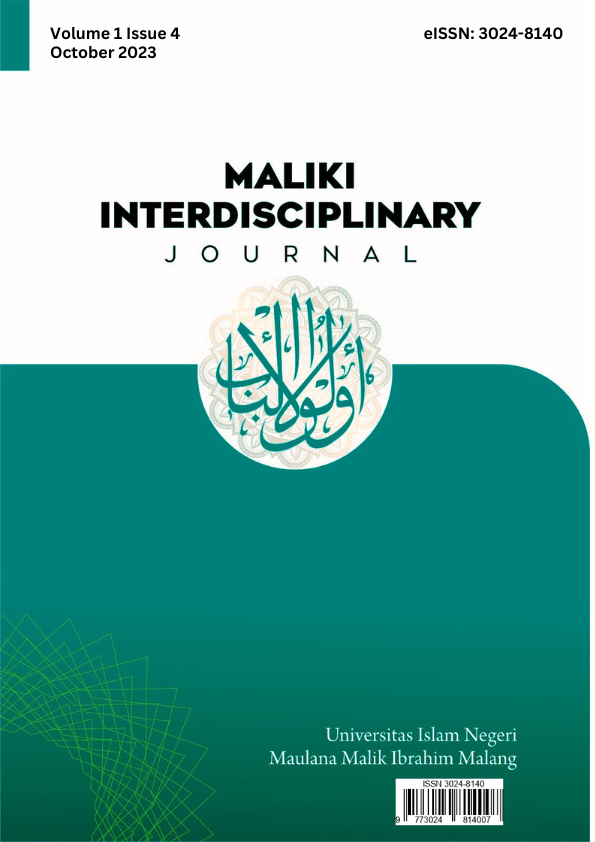Pelafalan huruf ع pada anak usia dini
Abstract
This article discusses the pronunciation of one of the Hijaiyah letters, namely ع in early childhood. Letters that are difficult to pronounce, both young and old. Early age is the age when a person is under 6 years old which is often referred to as the golden age, and is the period that determines a child's development. The period when children have a strong curiosity and will do anything to satisfy their curiosity. Therefore, an environment is needed to help shape children's development. As a follower of Islam, a Muslim woman is obliged to learn the science of reading the Qur'an (the science of tajwid). Not surprisingly, many TPQs or recitations are devoted to teaching small children to read the Al Quran. The teachers use different methods starting from Qiroati, Ummi method and many other methods.
Downloads
References
Al Azhim, D. A. L. E., & Kholidah, L. N. (2021). Problematika pelafalan huruf Hijaiyah pada anak usia dini di Rhoudhotu Tarbiyatil Qur’an (RTQ) Al-Ghozali Tlogomas Malang. JoLLA: Journal of Language, Literature, and Arts, 1(1), 62–75. https://doi.org/10.17977/um064v1i12021p62-75
Aulina, C. N. (2012). Pengaruh permainan dan penguasaan kosakata terhadap kemampuan membaca permulaan anak usia 5-6 tahun. Pedagogia : Jurnal Pendidikan, 1(2), 131–144. https://doi.org/10.21070/pedagogia.v1i2.36
Bayan, Y. N. (2008). Metodologi pembelajaran bahasa Arab (T. Sofyan (ed.)). Zein Al Bayan.
Harahap, N. (2020). Penelitian kualitatif (H. Sazali (ed.); 1st ed.). Wal ashri Publishing.
Humam, A. (2000). Cara cepat belajar membaca al Quran. Yogyakarta Team Tadarus “ ’ AMM”’.
Khasanah & Qosim, M. N. (2018). Sosiofonologis pelafalan huruf / ع / dalam huruf Hijaiyah pada masyarakat Jawa. The 6th University Research Colloquium 2017 Universitas Muhammadiyah Magelang (URECOL), January, 323–332.
M. Nur Sholihin. (2020). Peran ilmu al Ashwat dalam pelafalan huruf hijaiyah (kajianteoritik linguistik terapan). SALIHA: Jurnal Pendidikan & Agama Islam, 20(07), 110–127. https://doi.org/10.54396/saliha.v3i2.85
Marlina, L. (2019). Pengantar ilmu Ashwat. In Fajar Media Bandung (Vol. 1). http://digilib.uinsgd.ac.id/30539/1/PENGANTAR ILMU ASHWAT.pdf
Mufidah, N. (2018). Metode Pembelajaran Al-Ashwat. Al Mahāra: Jurnal Pendidikan Bahasa Arab, 4(2), 199–218. https://doi.org/10.14421/almahara.2018.042-03
Ningsih, A. A., & Fatimah, S. (2020). Metode sorogan sebagai model pemberantasan buta huruf Hijaiyyah bagi ibu-ibu rumah tangga di kota Malang 3(1), 1–7. http://repository.uin-malang.ac.id/7299/
Taufiqurrochman, R. (2020). Metode Jibril : teori dan praktik. El-Markazi.
Qardhawi, Y., Al-Kattani, A.H., Subhan, Salim (2004). Al-Qur'an berbicara tentang akal dan ilmu pengetahuan. Gema Insansi Press
Copyright (c) 2023 Hilmy Aqila Sukmono, Ninta Karina Berutu

This work is licensed under a Creative Commons Attribution-NonCommercial-ShareAlike 4.0 International License.
- Authors retain copyright and grant the journal right of first publication with the work simultaneously licensed under a Creative Commons Attribution License that allows others to share the work with an acknowledgement of the work’s authorship and initial publication in this journal.
- Authors are able to enter into separate, additional contractual arrangements for the non-exclusive distribution of the journal’s published version of the work (e.g., post it to an institutional repository or publish it in a book), with an acknowledgement of its initial publication in this journal.
- Authors are permitted and encouraged to post their work online (e.g., in institutional repositories or on their website) prior to and during the submission process, as it can lead to productive exchanges, as well as earlier and greater citation of published work.





